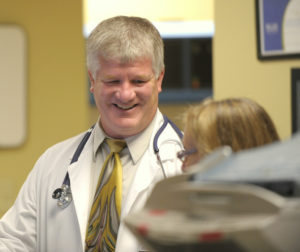A Q&A with Dr. Jim Augustine, ACEP Board Member and Chairman of the USACS National Clinical Governance Board

He is currently one of two USACS physicians on the ACEP Board. The other is Dr. L. Anthony Cirillo, who was elected to the Board last year. Jim is currently serving his sixth year on the Board. The terms are three years with a maximum of two, so this will be the end of Jim’s service. As he gets ready to depart, we spoke to him about his years of service and what others could maybe learn from his experience.
What is the role of the ACEP Board within emergency medicine?
Jim: The ACEP Board is responsible for moving the field of emergency medicine ahead with a set of responsibilities in Washington DC and in statehouses across the country. These are the places where the future of emergency medicine payment and regulatory oversight is set on a continual basis.
The Board members at ACEP have the responsibility to monitor challenges to emergency medicine, to make sure that our patients are well spoken for, and to make sure that practitioners in emergency medicine are treated fairly in their interface with hospitals, medical staffs, and in the community.
What is your advice for a new emergency medicine physician looking to follow your path?
Jim: Service like this is really a life-long commitment, beginning at the state level when I was an emergency medicine resident. Anyone who plans ahead for a career of service in medicine, has to begin to plan early on the ways they want to participate.
I became part of the state ACEP chapter and worked through committees of Ohio ACEP in order to become active in national ACEP, first at the committee level and then as a member of the Council, and then on to the Board of Directors.
Dr. Cirillo has also blazed the pathway that most emergency physicians should look to follow if they want to become active in leadership – he got involved early, was a leader in EMRA, was active at his local level, was active at the state chapter, and then took on opportunities to lead national programs at ACEP.
How do the day to day politics in Washington impact ACEP’s work?
Jim: The legislative arm of Washington DC is really just one of four arms of the federal government. The much more important one is the regulatory and financial arm, which has an ongoing life. Those are CMS and Department of Health and Human Services, and there is a lot of continuity in how the life of the DC bureaucrat proceeds. They have a time table and a life cycle of their own regardless of who is serving as head of the Department or as President of the country. They have a long-term direction they feel is right that goes beyond the scope of elections and politics.
What contributions during your time at ACEP have you been most proud of?
Jim: My biggest contribution has been participation and leadership in the development of the Clinical Emergency Data Registry.
When emergency medicine looked at this in 2013, I was asked to chair the task force that would design and then implement this program, which results in millions of dollars being paid to emergency physicians each year. I fortunately had a lot of background in the development and operation of registries because I had served the Emergency Department Benchmarking Alliance for many years.
We had learned in many years working with the federal government and regulatory agencies that careful design and implementation of a registry is necessary to both serve the needs of the people paying for a service, and as well as making sure that false measures are not a part of the process.
How did you approach making sure the registry really measured quality?
Jim: Our first attempts at working with the federal government resulted in very improper ways to measure quality – such as the necessity to do blood cultures for certain patients where that did not in any way benefit the patient. That resulted in major expense and patient inconvenience as well as a poor dashboard as to how to measure quality in emergency care.
What we instead focused on were measures with much more importance to the patient than simply time alone. We looked for evidence-based ways to combine timely care with the right care, with an emphasis on outcomes over simple process.
Quality markers also need to serve all of emergency medicine, not simply emergency physicians who practice in a certain kind of an ED. A lot of our literature comes out of academic sites that have a different range of services available to them, and it’s very easy for them to write certain procedures of how to take care of a certain difficult presentation that community environments won’t have any way of complying with.
What do you see looking in to the future of emergency medicine?
Jim: We in emergency medicine have a practice specialty that has a long-term future and one where careful planning and collaboration will be really important.
We have also created some of our own healthcare financing mess, because in a quiet and effective way, emergency physicians have been improving our overall public health and prevention of preventable deaths from burns, accidents, cardiac arrests, etc. That’s a tremendous and unrecognized healthcare success story.
But now, we have to think about older people with chronic health problems. Now we have to think about diseases of older people with conditions we haven’t solved yet – dementia, cancer, because more people are living older to get cancer – and we have to think about that as a success as well.
We always should be recognizing our successes. And emergency physicians have thankfully played a great role in that.

